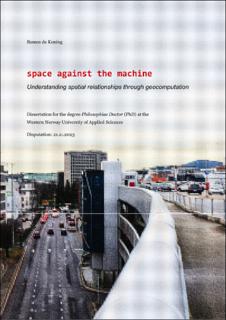| dc.contributor.author | de Koning, Remco Elric | |
| dc.date.accessioned | 2023-10-25T06:59:24Z | |
| dc.date.available | 2023-10-25T06:59:24Z | |
| dc.date.created | 2023-10-24T14:15:33Z | |
| dc.date.issued | 2023 | |
| dc.identifier.citation | de Koning, R. E. (2023). Space against the machine: Understanding spatial relationships through geocomputation [Doctoral dissertation, Western Norway University of Applied Sciences]. HVL Open. | en_US |
| dc.identifier.isbn | 978-82-8461-033-7 | |
| dc.identifier.uri | https://hdl.handle.net/11250/3098560 | |
| dc.description.abstract | Achieving sustainable development requires better evidence-based support for how cities work and how people could use existing data to better plan cities. This dissertation proposes novel approaches for the identification of the complex sociospatial relationships of urban structures and forms in relation to densification patterns and transport energy usage using spatial analysis. The dissertation proposes innovative methods to analyse complex and large digital datasets, and workflows to improve user-friendly access to appropriate geocomputational software tools.
Theories on spatial structures and urban morphology are combined to compare structures, forms, building density, land use mix and transport energy usage in two medium-sized cities, Bergen, Norway and Zürich, Switzerland. The research analyses how movement patterns, building density and land use mix are affected by the spatial configuration of the network of spaces, i.e. how roads, streets, and squares relate to each other. Findings indicate a correlation between spatial configuration, building density and land use patterns, and between transport energy usage efficiency and higher density areas. The novel method of spatial analysis with Space Syntax on a GIS platform allows diagnostic insights into how sustainable and equitable cities can be realised.
The dissertation contributes i) new data of spatial relationships on the macroscale and the microscale; ii) a systematic evaluation and understanding of cities across different contexts; and iii) automated geocomputational workflow for collecting, preparing and comparing spatial data, to demonstrate how graphical computer models can aid spatial planning professionals and decision-makers without extensive computer skills. Nonetheless, it is important to be aware of the limitations of overreliance on digital models versus the real world. Sensible translations of the above insights can provide useful support for monitoring and evaluation in planning, design and policymaking processes. | en_US |
| dc.language.iso | eng | en_US |
| dc.publisher | Høgskulen på Vestlandet | en_US |
| dc.relation.haspart | de Koning, R. E., Roald, H. J. & van Nes, A. (2020). A Scientific Approach to the Densification Debate in Bergen Centre in Norway. Sustainability, 12(21), 9178. https://doi.org/10.3390/su12219178 | en_US |
| dc.relation.haspart | de Koning, R. E., Tan, W. G. Z. & van Nes, A. (2020). Assessing Spatial Configurations and Transport Energy Usage for Planning Sustainable Communities. Sustainability, 12(19), 8146. https://doi.org/10.3390/su12198146 | en_US |
| dc.relation.haspart | de Koning, R. E., van Nes, A., Roald, H. J. & Ye, Y. (2017). Strategies for integrated densification with urban qualities: Combining Space Syntax with building density, land use, public transport and property rights in Bergen city. In: HEITOR, T., SERRA, M., SILVA, J. P., BACHAREL, M. & CANNAS DA SILVA, L. (Eds.), Proceedings of the 11th International Space Syntax Symposium, 3rd - 7th July, Lisbon, Portugal: Instituto Superior Técnico, Departamento de Engenharia Civil, Arquitetura e Georrecursos, #56 (pp. 863-879). http://www.11ssslisbon.pt/docs/proceedings/papers/56.pdf | en_US |
| dc.relation.haspart | de Koning, R. E., Heldal, R. & Tan, W. G. Z. (2022). Spatial data and workflow automation for understanding densification patterns and transport energy networks in urban areas: the cases of Bergen, Norway, and Zürich, Switzerland. Data in Brief, 42, 108290. https://doi.org/10.1016/j.dib.2022.108290 | en_US |
| dc.title | Space against the machine: Understanding spatial relationships through geocomputation | en_US |
| dc.type | Doctoral thesis | en_US |
| dc.description.version | publishedVersion | en_US |
| dc.rights.holder | © copyright Remco de Koning | en_US |
| dc.source.pagenumber | 225 | en_US |
| dc.identifier.cristin | 2188005 | |
| cristin.ispublished | true | |
| cristin.fulltext | original | |
